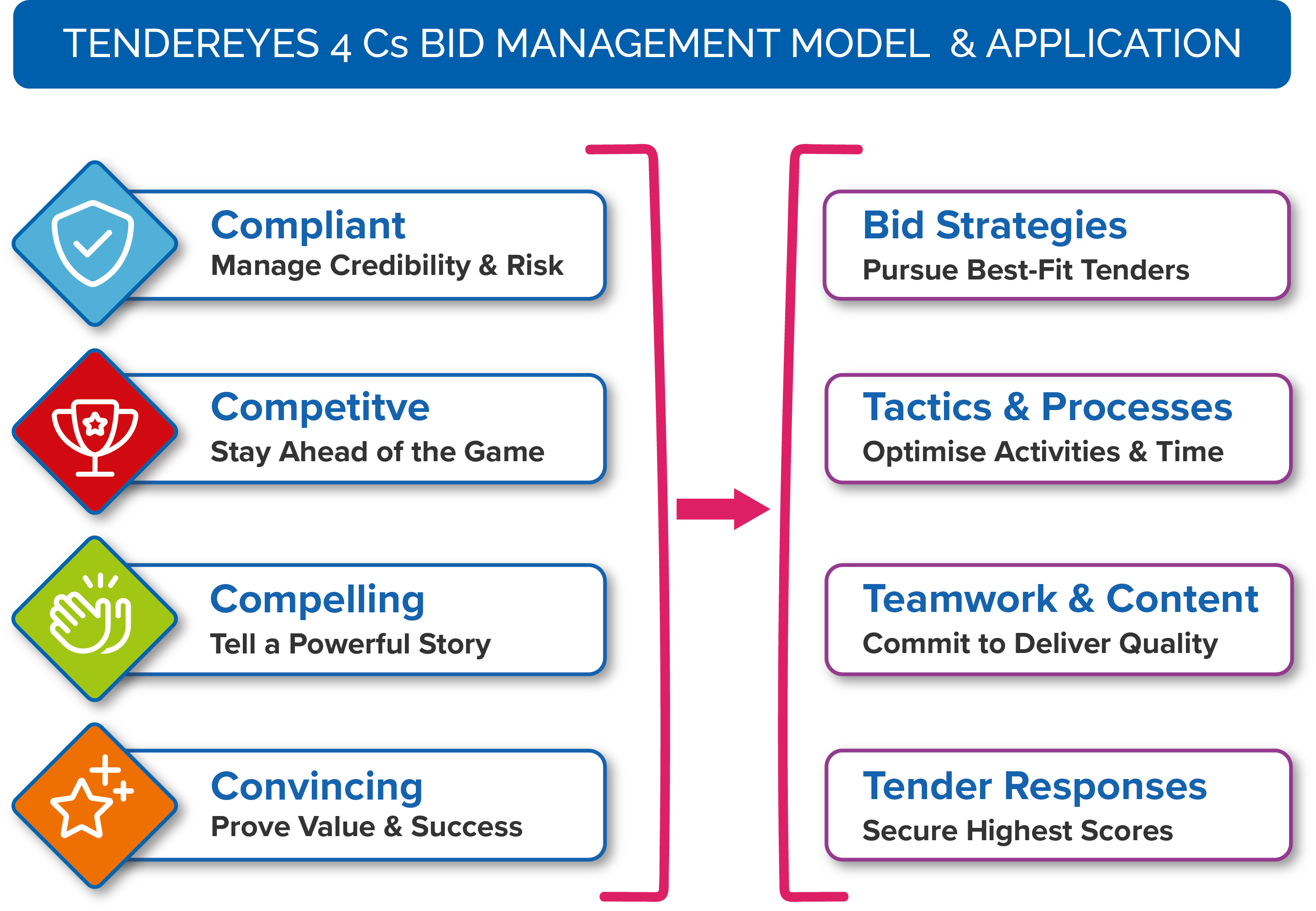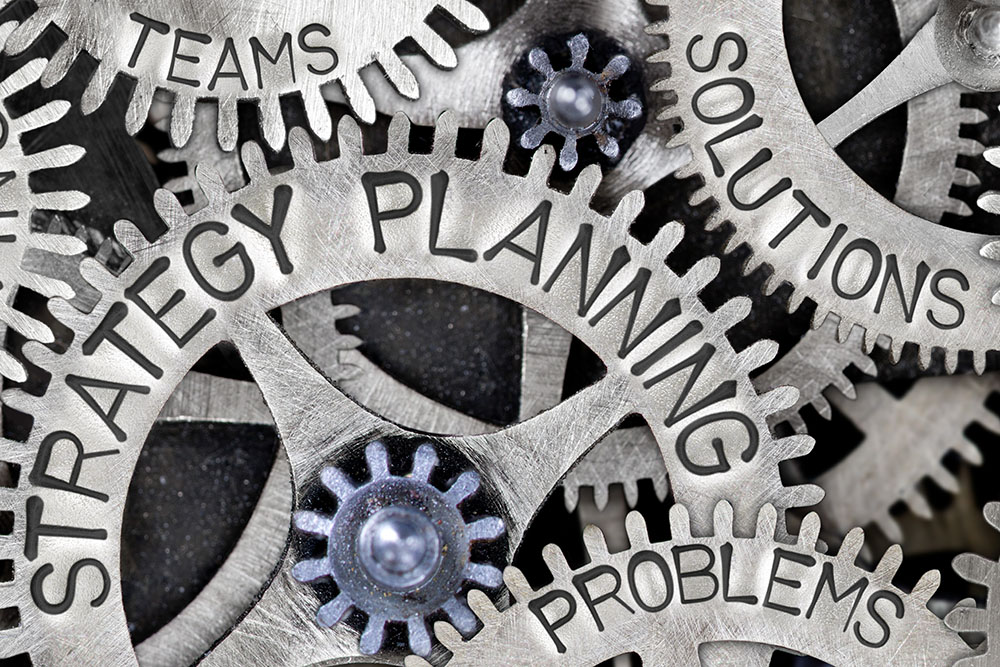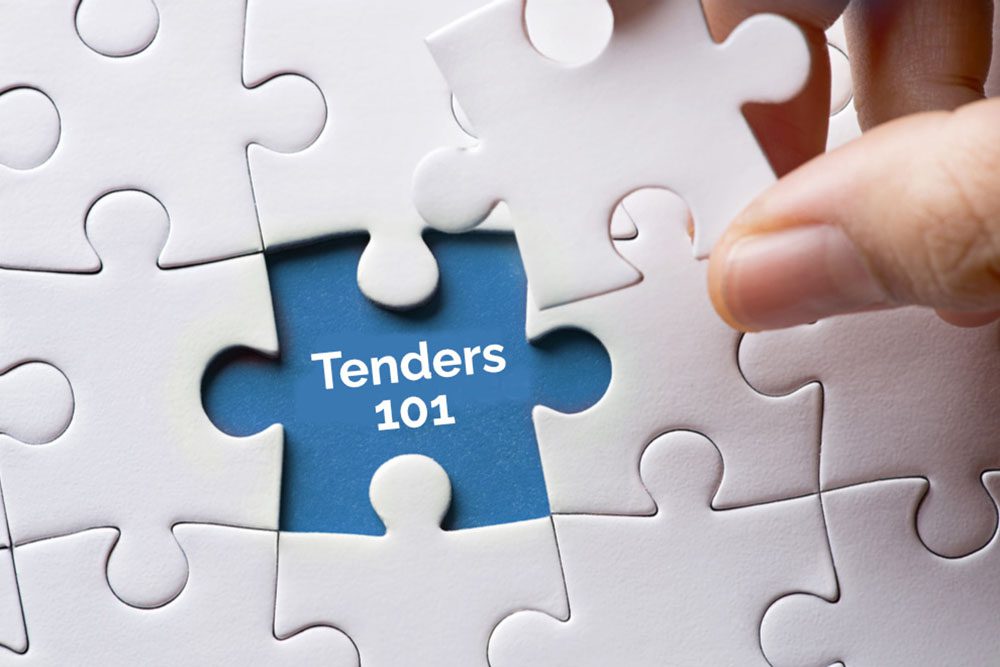In the intricate landscape of tender management, success hinges on a strategic approach that combines precision, persuasiveness, and adaptability. The TenderEyes 4 Cs Model consists of 4 elements – Compliant, Competitive, Compelling, and Convincing. This serves as a robust framework for organisations aiming to navigate the tender process with finesse. This blog introduces each C and explores how consideration of these elements when developing bid management strategies can lead to triumph in competitive tendering.
In the 2nd blog in this series we examine how the 4 Cs Model can be used in building better quality tender responses and bid submissions. And in the 3rd blog we demonstrate how to use the 4 Cs Model within the TenderEyes software.
Introducing the TenderEyes 4 Cs Model
The use of models and methodologies within business is well established, providing a consistent approach to undertaking tasks and analysis.
- Marketing strategists use PESTLE, Boston Matrix, SWOT & TOWS etc,
- Sales teams may adopt SPIN, NEAT, SCOTSMAN etc,
- Project managers may follow PRINCE 2, Six Sigma, Agile or Scrum.
While these models can be adapted and used within bid management, they only address specific elements of the bid journey. The TenderEyes 4 Cs Model offers an additional methodology that helps address top level business and bid strategies, right through to targeting strategies, collaboration and content, tender responses and submissions.
The model stems from the TenderEyes Team’s passion for world-class bid management best practice and a wealth of operational, executive, and bid governance expertise. Together with longstanding working and collaboration with highly experienced corporate bid professionals.

Applying the TenderEyes 4 Cs Model for Bid Management Strategies
Let’s now examine how the 4 Cs Model can be adopted for the development of business and bidding strategies and processes.
1. Compliant: Business Alignment
Bidding for high value complex tenders is a huge investment in time, resources and money. Bidding for mis-matched opportunities puts undue pressure on your Bid Team and Subject Matter Experts. This wastes valuable time that could be better spent finessing better matched, higher win probability bids.
Internal compliance is therefore the foundation of any bid strategy or tender submission.
- Bid Objectives: Ensuring pursuit decisions are aligned to business values, objectives and goals is paramount. Consideration also needs to be given to the businesses capacity to deliver the tender submission and contract. Potential outcomes such as securing a profit, or a strategic R&D win need to be factored into qualification strategies.
- Bid Decisions: Poor decisions, that do not meet your bid objectives, can open your business up to both financial and reputational risk. It is therefore essential that your bid strategies and processes include robust approval and sign-off procedures. These need to cover qualification and pursuit decisions, content creation, responses, and final tender submissions.
- Governance: Ensuring compliance of these business-critical decisions across the whole bid journey, will be vital for ongoing governance, risk management and protection of Intellectual Property. Undertaking regular audits and performance reviews should be integrated into your bid management processes.
2. Competitive: Smarter Targeting
In developing your business and bid strategies, it is essential to consider your competitive environment and use this knowledge wisely to make better informed decisions.
- Market Insight: Staying vigilant and agile to market changes, threats and opportunities is vital to long-term sustainability and success. This may include reacting to changing client needs, new competitor activity, product innovations and potential new markets. It may also require exiting from wrong markets or tenders with product misalignment. Benchmarking, tracking and understanding your market share and win rates will be required to ensure assumptions are not made and reality informs strategy and decision-making.
- Competitor Intelligence: Your bid strategies need to include regular competitor reviews and updates. As well as make analysis available to all involved in tendering. Intelligence needs to be compiled using multiple sources such as online research and employee feedback. This will help ensure accuracy of information and knowledge. Having a detailed understanding of competitor market activities, positioning, products and pricing will be essential to develop strategic competitive differentiation and advantage.
- Pursuit Decisions: It is very easy for businesses to fall into the “Bid for Everything” mentality. But so vital to ensure your sales targets are based on market insight, competitive intelligence, and realistic win probabilities. Having a robust qualification model, such as SCOTSMAN, in conjunction with the TenderEyes 4 Cs Model, will help ensure your sales team make consistent well-informed decisions. Qualifying and prioritising your best-fit, business aligned opportunities will help focus resources and time on delivering quality bids not quantity.
3. Compelling: Generating Excitement
The success of any bid is the professionalism and hard work of the people involved. This will include multiple teams, divisions and disciplines, all working to tight deadlines and in some instances within different geographies and time zones.
Adoption of the TenderEyes 4 Cs Model will help keep teams motivated and working to the common bidding goal, requires employee engagement and collaboration.
- Build the Vision: Ensuring employees are fully conversant with your business objective and goals and how you plan to achieve them is critical to success. Bidding decisions need to provide a compelling proposition for the business and those involved in putting the tender together.This may of course include financial rewards but could also be the kudos of establishing an innovation or product in the marketplace or successfully entering a new market. Generating a level of excitement and conviction for winning the contract will be important for buy-in and commitment by all contributors.
- Brand Buy-In: Developing a strong brand image and reputation in the marketplace is vital. Your marketing strategies will need to include the building of a captivating brand story that fosters trust and reliability. This will provide a strong foundation for pursuing high-value contracts.
- Team Motivation: Strong teamworking is an essential component of successful bid management. This requires a collaborative culture, that encourages communication, enquiry, feedback learning, and innovation. Fostering accountability and providing the right tools will help empower teams to give their best. It is also important to celebrate the wins, review performance and plan for ongoing improvement and excellence.
4. Convincing: Providing Evidence
You may have a compelling brand story or bid proposition but without evidence of success how do you convince procurement agencies to score your tender responses highly and award your business the work?
- Deliver the Mission: Having built a compelling brand story it is vital to engage and support your teams to ‘live and breathe’ your brand values and help build brand credibility and trustworthiness. Securing high levels of employee retention and satisfaction will help ensure long term continuity and commitment to bidding goals and activities. Qualification strategies that focus on pursuit of bids with higher win probabilities will also help convince your teams to commit time and energy into the tender process. A succession of lost bids will only result in wasted effort and demotivated teams.
- Build Credibility: Internal strategies also need to focus on securing evidence of contract delivery success. This will include a range of strong customer testimonials and case studies that highlight value for money, innovative approaches and customer benefits. In addition, securing individuals within your established customer organisations that can act as your champions and are available as references for prospective clients to engage with. Securing such evidence is a challenge for any business, especially when dealing with a wide range of products, services and industry sectors. This needs to be a proactive and regular activity to ensure your credibility as a reliable and trustworthy supplier.
- Customer Retention: Another powerful tool to use within tender submissions is evidence of customer retention and satisfaction. Strategies to ensure successful contract delivery, robust account management, support and good issue resolution practices are all essential. Benchmarking, recording, analysing and reporting on service metrics & KPIs and customer satisfaction surveys and reviews are additional tools that can provide confidence and convince of your suitability t o deliver contracts.
Benefits of the TenderEyes 4 Cs Model in Tender Management
Incorporating methodologies, such as the TenderEyes 4 Cs Model, into organisational practices, can lead to a range of benefits, supporting strategic planning, operational excellence, and successful bid outcomes.
Benefits may include:
- Strategic Alignment: Ensuring bid strategies maximise opportunities associated with external factors, while internal processes and activities stay focused on achieving these high-level objectives and goals.
- Risk Management: Assisting in identifying and mitigating risks associated with external influences and internal strengths and weaknesses. As well as providing a framework for consistent working and good governance.
- Customer-Centric Approach: Focusing on understanding client needs, fostering stronger relationships, and tailoring solutions and tender responses to meet specific customer requirements.
- Operational Efficiency: Helping identify, eliminate inefficiencies and defects in bid processes as well as streamlined workflows and improved time management.
- Standardisation: Fostering consistency in process, activities, collaboration, content and tender submissions.
- Improved Decision-Making: Providing valuable insights for informed decision-making, in their strategic and operational choices and all stages of the bid journey.
- Quality Assurance: Contributing to reduced errors and improved collaboration, content and tender responses.
- Adaptability to Change: Helping to anticipate and adapt to changes in both the external and internal environments. Ensuring optimised resources and activities are focused on best-fit tender opportunities.
- Enhanced Collaboration: Facilitating clear and effective communication and teamworking within the organisation.
- Higher Win Probabilities: Delivering better quality content and tender responses that secure higher evaluation scores and win more business.
Summary
Embracing the TenderEyes 4 Cs model — Compliant, Competitive, Compelling, and Convincing — empowers organisations to approach tender management with a holistic and strategic mindset. By meticulously addressing each element, businesses can not only meet the requirements of the procuring agency but also differentiate themselves, compellingly positioning their offerings as the ideal choice. This model serves as a roadmap for success in the dynamic and competitive landscape of tender management.









